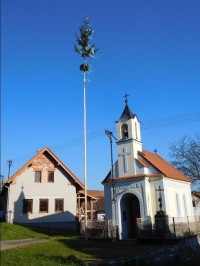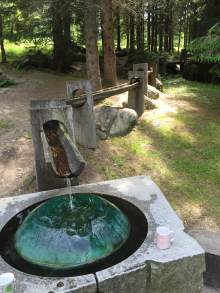 Pelišky was one of the first movies I watched in the Czech Republic. It takes place in the year (maybe years) before the Soviet Occupation. It follows the lives and struggles of ordinary families. One of the best and funniest scenes takes place at a small post-wedding dinner. The couple receives some new-fangled plastic spoons as a wedding present. The gift-giver is very proud of the fact that they were made in Eastern Germany. One of the characters stirs her tea with the spoon and is about to lick it but as she takes it out of the hot tea it bends as if it was made of rubber. Soon the scene dissolves into arguments, frustrations and disappointments.
Pelišky was one of the first movies I watched in the Czech Republic. It takes place in the year (maybe years) before the Soviet Occupation. It follows the lives and struggles of ordinary families. One of the best and funniest scenes takes place at a small post-wedding dinner. The couple receives some new-fangled plastic spoons as a wedding present. The gift-giver is very proud of the fact that they were made in Eastern Germany. One of the characters stirs her tea with the spoon and is about to lick it but as she takes it out of the hot tea it bends as if it was made of rubber. Soon the scene dissolves into arguments, frustrations and disappointments.
Another memorable scene I remember was around New Year’s Day. An older couple pour melted aluminum into a bowl of water then pull it out and examine its shape in an attempt to divine what the new year will hold. Neither can agree on its shape or its meaning.
As most readers already know, within Communism, religion is highly suspect, mainly I think, for the ways in which it differentiates between people and also often builds a community and/or allegiance that is not part of the system. So it is interesting to catch details of religious rituals in the film. Perhaps they continued under Communism because they do not need institutional structures or religious leaders to continue. What is even more interesting is the fact that many of these rituals still continue.
Here I would like to introduce the ones I have encountered and what I understand their meanings or purpose to be. But before I do that, I want to say something about the nature of the rituals. First, many of them are attached to or associated with a Christian holiday even though they often have no obvious connection. Yet, second, many Czechs understand these rituals as an integral part of the celebrations of these holidays. In addition, there is such an acceptance of these as Czech that there is very little discussion or critique of the rituals (that I have encountered as of now).
Here are some examples of rituals associated with Christianity. During Christmas Eve it is traditional to fast for the day. It is believed that those who fasted for the day will see a golden pig. This also signifies the fast will produce good results. Most families, yes even Jewish ones, have trees in their houses and gather on Christmas Eve for a traditional dinner of fried carp, potato salad and cucumber salad. At the meal, coins, or sometimes fish scales, are placed under the plates. Finishing the meal reveals the coin or scales, a promise of riches in the next year.

One tradition of divination I already mentioned was the hot metal poured into water. In another ritual, you throw a shoe over your shoulder and depending on how it lands, it will tell you if you will remain single or get married within the next year. In yet another, you light a small candle glued to the inside of a walnut shell. This little boat is then placed on water. Its direction and movement also predicts the future.
Easter day brings pomlezká, long bunches of willow braided and tied with beautiful ribbons. These are given to boys to hit girls with on the day. Sometimes it is common for girls to then give boys candy for doing so. Easter also brings out what we, in Judaism, call groggers, or noise makers, that boys spin as they collect candy. (I’m pretty sure most Czechs have no idea these groggers come from the Jewish festival of Purim.) There is also the tradition of boys throwing water on girls, vice versa in some places.

What draws me to examine the pagan roots of these rituals is the fact that April 31st– May 1st has similar traditions. April 31st is pálení čarodějnic, or the Burning of the Witches. Large fires are lit (fires of Beltane, anyone?) and people often burn effigies of witches (I’m told they represent winter). On May 1st, a majka, a pole decorated with green branches and ribbons, is erected in the village. Young men stay up all night to prevent other young men from stealing it. On May 1st, the water throwing, hitting with the pomlezká and egg or candy giving happens again.
Other pagan rituals are not necessarily associated with a specific holiday. Many center around water. There is the vodník, or water man. These wooden statues are found almost everywhere there could be human interaction with water. For example, it is quite common to see them next to a bridge that crosses a stream or in the water reservoir of villages. There are also healing waters. Each spring is a pilgrimage spot and has its own health benefits.

Some of these rituals are quite problematic from a feminist perspective, especially the ones where ritualized violence is acceptable: burning witches and boys hitting girls with sticks. There is also the assumed heterosexuality (heterosexism) of many of the traditions involving water throwing and future divining. In addition, I have witnessed a man, hungry with patriarchal power, surprisingly drench the women of the village with a fire hose. I was furious!
Nonetheless, I am fascinated by the way in which many Czechs associate these rituals with Christianity when they are quite outside of the tradition. At the same time, for many people, Christianity also seems so distant from Christian rituals that many people also misinterpret some of its rituals.
For example, presents are given on Christmas Eve by baby Jesus. Baby Jesus in Czech is ježíšek. Hedgehog in Czech is ježek. Sometimes, children think that baby hedgehogs (ježiček) give presents on Christmas Eve, not Jesus. (The words, for baby Jesus and the diminutive form of hedgehog, signifying a baby hedgehog, sound very similar when pronounced.) I love the idea that baby hedgehogs bring gifts to children in the middle of the winter. I smile at the thought.
I’m interested to see what the future holds for these rituals in what is often considered one of the most secular countries in Europe. I also wonder how an influx of immigrants of different religious backgrounds as well as a small but steady rebuilding of Czech Judaism will influence these “Christian” rituals. Finally, I’m curious to discover how the growing movement of Czech versions of both feminism and gay rights in the Czech Republic will respond. Perhaps I need some melted metal and a bowl of water to find out.
Ivy Helman, Ph.D. is feminist scholar and faculty member at Charles University and Anglo-American University in Prague, Czech Republic where she teaches a variety of Jewish Studies and Ecofeminist courses. She is an Associate of Merrimack College‘s Center for the Study of Jewish-Christian-Muslim Relations and spent many years there as an Adjunct Lecturer in the Religious and Theological Studies Department.


I, also, smile at the thought of baby hedgehog bearing presents. Thank you for a very interesting and informative article.
LikeLike
Fascinating. Reminded me of Easter here and the Easter bunny and the egg hiding.
LikeLike
The same phenomenon is found in rural Greece. But I don’t know how long it will last. I think the reason we don’t have holy wells, sacred trees, etc. in the US is because in the US Christianity has almost no connection with the land. In Europe in contrast, Christianity was forced to deal with living pagan traditions in agricultural societies, and where they could not be stamped out, to incorporate them. I find that in Greece the people who participate in the kinds of traditions you describe have no idea that they are preserving pre-Christian traditions. To admit would be to go against the church and nobody does that. They may ignore the church but only a few intellectuals object to its hegemony.
LikeLike
Reading your descriptions Ivy, I was wondering if these rituals can be labeled either “Christian” or “Pagan” or “Jewish”. I’m left with the questions of how do we create ritual, and what does it express of the community’s needs, desires, hopes? Most of all, how can we create rituals that are life giving for everyone in the community and that encourage us to grow in patience, peace, and compassion? Of course this will be different for each place, and time. And perhaps one day soon, one of the girls being hit by one of the boys, will give him a black eye instead of candy – and there will be a whole new ritual!
LikeLike
Thanks Ivy. I am touched by the baby hedgehogs and their gifts!! Organized religion seems to hold back the spontaneity and unknowing we need in order to realize the deeper truths of existence. The best spiritual teacher is maybe love and life itself.
LikeLike
Thanks for sharing these fascinating rituals, Ivy. So from now on I’ll think of Baby Jesus the hedgehog and smile. Carol, I was also struck by your comment that the reason we don’t have holy wells, sacred trees, etc. in the U.S. is because we are so disconnected from nature. You are probably right about that. Of course Native people believe the rivers and mountains are sacred, but the average American doesn’t. I feel a connection to Christianity and to earth-centered spirituality and the Goddess, which is why I was so surprised and thrilled when my minister held a water communion service recently in which we invited the rivers and creeks to worship with us, along with the fauna. We were invited to name the creatures of the river joining us in praising our Creator. I think if more churches held services like this it might help us connect to Mother Earth and treat her better.
LikeLike